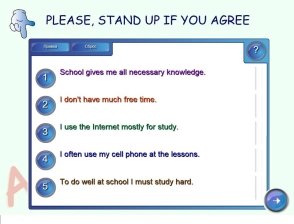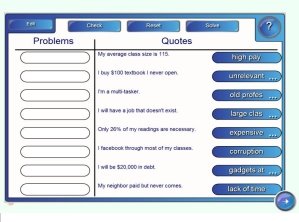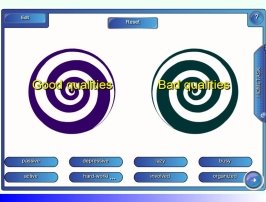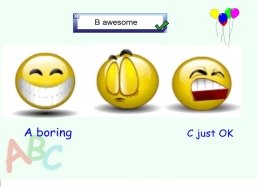Lesson Plan "Education in the Modern World" (11th form)
It's the lesson of systematization and revision of knowledge of the module “SCHOOL LIFE”. It is aimed at encouraging students to think critically about their role in the educational process and understand the importance of active personal involvement in studies. The lesson also provides a possibility to compare the problems of American high schools and Ukrainian ones. In this way students come to their own conclusions about common problems in modern education.
Oksana Kholod
Master Degrees in Philology and
Management of Educational Establishments
Teacher-methodologist
Gymnasium №93, Zaporizhzhіa
INTRODUCTION. EASY WAYS TO USE SMARTBOARD
Many students see learning as difficult, frustrating or just plain boring, but it doesn’t have to be that way. If you use a Smart Board, you have the opportunity to transform your lesson into a hands-on, interactive learning experience. For students of all ages, Smart Board means having plenty of smart choices that makes learning as painless and fun as possible.
Interactive boards are used as a learning and teaching tool or visual representation that demonstrates what students would see on a computer desktop. There are different types and styles, as well as different software programs and resources.
Smart boards have got a lot of benefits:
- adapt the lesson to include opportunities for different learning styles: visual, audio, kinaesthetic, brain-based learners;
- offer new methods that make the classroom environment more interesting and more engaging by involving students;
- teachers and students can edit and add to what is already on the board and all the information can be saved and printed to avoid copious note-taking;
- teachers can present the lessons using text, sound, video, DVDs, CD-ROMs or television and Internet links;
- can be used as an assessment tool because any work done on the board is recorded.
But there are some drawbacks:
- there are numerous costs in both the establishment or installation of a Smart board and its maintenance;
- extra personal development and training for teachers is required which needs time and sometimes money costs;
- you can not use permanent markers as this may damage the board and this can cause expensive replacement;
- as the board is usually the main focus of a lesson, if any breakages or damage occur, the lesson would be interrupted.
To work with a Smart Board of any kind you can use Smart Notebook which is the software suite that powers the board’s many learning options. Using it, you can build your own language tools, from hands-on activities to visually stimulating lessons featuring slides, videos and sounds.
Nevertheless, it is important to remember that only a Smart board will not solve all the problems instantly. And of course, teachers are not required to work with the Board constantly, at every lesson. Sometimes the Board can be useful only in the very beginning of class or during the discussion. Teachers can combine traditional methods and electronic media at their lessons. Everything depends on the creativity of a teacher, his readiness to make the lesson interesting, understandable and memorable.
LESSON EXAMPLE
TOPIC: EDUCATION IN THE MODERN WORLD.
LESSON TITLE: A Vision of Students Today
CONCEPT: It's the lesson of systematization and revision of knowledge of the module “SCHOOL LIFE”. It is aimed at encouraging students to think critically about their role in the educational process and understand the importance of active personal involvement in studies. The lesson also provides a possibility to compare the problems of American high schools and Ukrainian ones. In this way students come to their own conclusions about common problems in modern education.
INTENDED LEVEL: Upper-Intermediate (B 2), 11th form
DESCRIPTION OF THE CLASS: Group A, aged 16
INSTRUCTIONAL MATERIALS AND RESOURCES: Smart board, Video “A Vision of Students today”
http://www.youtube.com/watch?v=dGCJ46vyR9o
- Handouts, cards of self-assessment
INSTRUCTIONAL OBJECTIVES:
Practical: - to practice using active vocabulary on the topic
- to develop pupils’ speaking skills
Educative: - to cooperate group work
Developing: - to teach pupils to analyze, compare, identify the main idea of the material and to express their own point of view
Cultural: - to stimulate personal awareness of oneself as an active participant of the educational process
PROCEDURE
STARTING THE LESSON
Hello, my friends. Glad to see you. I’m sure you’re looking forward to learn something new. Each student is given the handout:
|
I am a …. a … a … a …. a … |
I THINK-PAIR-SHARE ACTIVITY “The roles in life” (2 min)
SLIDE 1

We’ll start from THINK-PAIR-SHARE activity.
- At first think about the roles you play in your life and write them on these papers. There should be at least five words. The time is fixed.
(The students make their lists on the papers)
- Then turn to each other and tell your roles with your partner.
- And now let’s share your ideas with the rest of the class. Tell me, what are your roles? Some students stick their papers on the board.
So, you can see there is a diversity of the roles which we play in our lives. But most of you name such a role as a student. I think you agree that it is one of the most important ones in the modern world.
SLIDE 2 There is a picture of a student on the board.

ІІ INTRODUCING THE TOPIC AND THE EXPECTED RESULTS (0.5 min)
SLIDE 3 What do you think is our today’s topic?

At the previous lessons we spoke about studying at schools, passing exams, choosing the university, studying abroad.
SLIDE 4-5


Today we’ll revise the active vocabulary on the topic, watch the video about the students’ problems, compare and identify the main idea of the material, have a discussion to develop the speaking skills, present your own point of view.
At the end of the lesson we try to create an image of an effective learner and find some ways of being successful in your future study during the last year at school as well as at the university.
So, the topic of our today’s lesson is A Vision of Students Today.
ІII WARMER. HOT SEAT (2 min)
SLIDE 6

We need to revise the vocabulary units on the topic. Let’s have such an activity as Hot Seat. I need 1 volunteer. Instructions:
- A volunteer stands with his/her back to the board and there will be some words from our previous lessons on the board.
- The pupils should define these words for the volunteer to guess.
course, mark, assignment, fail, term, pass
Well-done. You know our vocabulary units of the topic perfectly well.
MAIN PART
BEFORE-WATCHING ACTIVITIES
IV SPIDERGRAM “What kind of students are we?” (2 min)
SLIDE 7-8


Let's focus on your role as a student and make a spidergram. Name some main characteristics of a student today using any descriptive adjectives.
So, this is your vision of a student and it’s not very optimistic.
V SLIDE 9
“PLEASE, STAND UP IF YOU AGREE” ACTIVITY “The personal educational experience” (2 min)

I'd like all of you to think about your experience in studying. Please, stand up if you agree with the following statements and share your point of view. We’ll count the results.
- School gives me all necessary knowledge.
- I use the Internet mostly for study.
- I don’t have much free time.
- I often use my cell phone at the lessons.
- To do well at school I must work hard.
So, all of you had the opportunity to reflect on and evaluate your own experience and your classmates’ ones about studying.
VI SLIDE 10
PRESENTING THE VOCABULARY UNITS. IMAGE IDENTIFICATION (2 min)

Some words from the video are presented before watching it. These are the pictures of the words which are either difficult to understand or which can help to predict the content of the video. The students have to choose the right definition for each picture.
Good for you. I hope it will help you while watching the video.
VII SLIDE 11
WHILE-WATCHING ACTIVITY. WATCHING THE VIDEO (5 min)

We'll watch the video “A Vision of Students today” http://www.youtube.com/watch?v=dGCJ46vyR9o. It was created by Michael Wesch in collaboration with 200 students at Kansas State University and includes some students‘ messages. Watch it attentively to be ready to discuss it afterwards. Pay attention to the numbers in the video.
AFTER-WATCHING ACTIVITY
VIII QUIZ. MULTIPLY CHOICE (2 min)
So, what is the main idea of this video? What are their main problems?
Right you are. The most important characteristics of the American students today are presented in it:
- how they learn and what they learn;
- their goals, hopes and dreams;
- what their lives will be like and what kinds of changes they want to have.
SLIDE 12
Let’s check what you remember from the video. Choose the right number to complete the facts.

Great! I see you have watched the video very attentively.
IX SLIDE 13 DRAG-AND-DROP TABLE (3 min)

To check the understanding of the content of the material there is a drag-and-drop table. The students’ messages from the video and the names of the problems are given in two columns. The students should drag a problem to the corresponding message.
Well, we’ve defined the main problems of the students’ life. But it’s important to know how to cope with all these difficulties.
X GROUP DISCUSSION (8 min)
- To find the solutions of these problems we’ll have a group discussion.
- You can see these problems, students can face while studying in universities, on the board You have to choose three problems, which are the most crucial from your point of view.
- Then you should suggest a few ways of how these difficulties can be solved out to make the students’ life easier and as a result the process of education more effective.
- The results of your discussion must be written in short on these posters and then choose three members of your group who will present your ideas. One person must talk about one item of your poster. You’ll have … minutes to discuss and note your ideas.
XI PRESENTING THE DISCUSSION RESULTS (7 min)
Every group presents the results of the discussion. You can see the main ideas on their posters. Listen to the presenters very attentively.
So, your ideas are true. We can make a conclusion that without high personal motivation and students’ own efforts it's difficult to have good results in study. I hope each of you will do his best to be a purposeful and effective to cope with all difficulties and succeed in your study.
ENDING THE LESSON
XII SLIDE 14
SUMMING UP. VORTEX SORT ACTIVITY. “Good/Bad Qualities” (2 min)

Let's try to divide these qualities into two columns. So the first column represents what should be the main characteristics of students in the modern world to reach their goals and succeed.
As you can see that it is very important to be an active participation of the educational process and develop high personal motivation while studying. Everything depends on you!
XIII SLIDE 15 HOMETASK (0.5 min)

Your home task for the next lesson is to write an essay “The main features of the students’ life today”.
XIV EVALUATION. REFLECTION (2 min)
It’s high time to pay and receive compliments. Thank you very much for your enthusiasm and original ideas. The most of you were at the top. Some of you had a few mistakes. But it’s better to make mistakes than to say nothing. I’ll look through your cards of self-assessment and put you the marks. Hope you’ll work equally well at the next lesson.
SLIDE 15

And at last I’d like that you evaluate our today’s lesson. Look at the board attentively and choose the letter which is close to your opinion about the lesson. Everyone has these letters on your desks.
APPENDIX
VIDEO TAPESCRIPT A Vision of Students Today
“Today’s child is bewildered when he enters the 19th century environment that still characterizes the educational establishments here information is scarсe but ordered and structured by fragmented, classified patterns subjects, and schedules.”
Marshall McLuhah 1967
If these walls could talk, what would they say? If students learn what they do … What are they learning sitting there? The information is up here. Follow. Of course, walls and desks cannot talk. But students can. 200 students made 367 edits to this document and surveyed themselves to bring you the following message
- My average class size is 115
- 18% of my Teachers know my name
- I complete 49% of the readings assigned to me. Only 26% are relevant to my life
- I buy hundred dollar textbooks that I never open
- My neighbor paid for class but never comes
- I will read 8 books this year. 2300 web pages and 1281 Face Book Profiles
- I will write 42 pages for class this semester and over 500 pages of email
- I got 7 hours of sleep each night.
- I spend 1 ½ hours watching TV each night
- I spend 3 ½ hours a day online
- I listen to music 2.5 hours a day
- I spend 2 hours on my cellphone
- Spend 3 hours in class, 2 hours eating
- I work 2 hours every day, 3 hours studying
- That’s a total of 26.5 hours per day
- I am a multi-tasker (I have to be)
- I will be $ 20,000 in debt after graduation!
- I’m one of the lucky ones. Over 1 billion people make less than $ 1 a day
- This laptop costs more than some people in the world make in a year
- When I graduate, I will probably have a job that doesn’t exist today
- Filling this won’t help me get there or deal with War/ Ethnic conflicts/ Hunger, etc
- I didn’t create the problems but they are my problems
- Some have suggested that technology can save us …
- I facebook through most of my classes
- I bring my laptop to class, but I’m not working on class stuff
“The inventor of the system deserves to be ranked among the best contributors to learning and science, if not the greatest benefactors of mankind”
Josiah F. Bumstead 1841
… on the benefits of the blackboard
Writing on the chalkboard forces the teacher to move …
Бачення студентів cьогодні
"Сьогоднішня дитина збита з пантелику, коли вона входить в середовище 19 століття, що все ще характеризує навчальні заклади, де інформація мізерна, але упорядкована і структурована фрагментованими, класифікованими структурами предметів, розклідів."
Маршалл Маклухах 1967
Якби ці стіни могли говорити, що б вони сказали? Якби студенти вивчали, що вони повинні...
Чому вони навчаються, сидячи там? Інформація тут. Слідкуйте.
Стіни і столи звичайно не можуть говорити. Але студенти можуть.
200 студентів написали 367 коментарів до цього опитування і провели опитування, щоб
принести донести до Вас наступні повідомлення:
- Середній розмір мого класу становить 115.
- 18% моїх вчителів знають моє ім'я.
- Я закінчила 49% завдань, які я повинна була зробити. Тільки 26% можуть знадобитися мені в житті.
- Я купив підручників на сто доларові, але я їх ніколи не відкривав.
- Мій сусід заплатив за навчання, але ні разу не прийшов.
- Я прочитала 8 книг цього року, 2300 веб-сторінок і 1281 профілів в Facebook
- Я написала 42 сторінки на заняттях у цьому семестрі і більше 500 листів в електронній пошті
- Я сплю7 годин щоночі.
- Я витрачаю 1,5 години на перегляд телевізійних програм щовечора.
- Я сиджу 3, 5 години на добу в Інтернеті.
- Я слухаю музику 2,5 години на день.
- Я розмовляю по моєму мобільного телефону 2 години на день.
- 3 години проводжу на заняттях, 2 години витрачаю на іжу.
- Я працюю 2 години кожен день, 3 години витрачаю на домашнє завдання.
- Це в цілому 26,5 годин на добу.
- Я виконую багато речей одночасно (я повинна це роботи).
- У мене буде $ 20000 боргу після закінчення університету.
- Я один з щасливчиків. Більше 1 мільярда людей заробляють менше 1 долара в день.
- Цей ноутбук коштує більше, ніж деякі люди в світі отримують за рік.
- Коли я отримаю диплом, я буду мати професію, яка, ймовірно, не існує сьогодні.
- Заповнення цього лотерейного квитку нічим не допоможе мені і не впливатиме ніяк на Війни / Етнічні конфлікти / Голод, і т.д.
- Я не створювати проблем, але це і мої проблеми.
- Дехто вважає, що технології можуть врятувати нас ...
- Я проводжу час у facebook на більшості моїх занять.
- Я приношу свій ноутбук в клас, але я не використовую його, щоб працювати на уроці.
"Винахідник цього виробу заслуговує щонайменше на те, щоб бути серед людей, які більше всього вклали у навчання та науку,а може і на те, щоб вважатися найвидатнішим благодійників людства.”
Йосіф Ф. Бамстед 1841
... на честь шкільної дошки
Працюючи у дошки, вчитель заохочується до того, щоб рухатись …


про публікацію авторської розробки
Додати розробку
